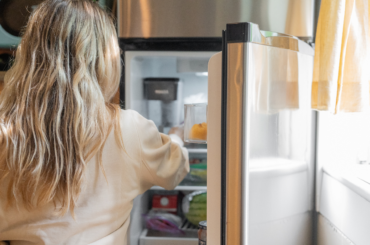Click to download FREE PRINTABLES for all our 30-day family challenges!
Gratitude is not just something to mention once a year at the Thanksgiving table or around the holiday season. Making thankfulness part of our everyday lives has many benefits for families.
Teaching gratitude to kids can lead to higher levels of happiness, physical and mental wellbeing, self-worth, optimism, and resilience during tough times. Regularly practicing gratitude makes kids (and adults) less materialistic, jealous, entitled, and negative. Sounds like a win for the whole family!
But gratitude is an abstract concept, so how do you incorporate it into your family life in ways that kids will really take to heart? Below are 30 creative ideas for making thankfulness more meaningful—and fun!
1. Gratitude game
To get the ball rolling with thinking about gratitude, you can complete a fun scavenger hunt that will have everyone in your family thinking about all the things they’re thankful for—just print off this free checklist, snap photos of (or simply write down) each thing on the list as you find it, and check them off! Make it a race, or just reconnect when everyone’s finished and share what you found!
Or try this easy game with Skittles or M&Ms (or any type of snack, stickers, blocks, etc. that comes in five different colors). When a player randomly selects a color, they have to name something that they’re grateful for in the category that matches that color, whether it’s a person, place, thing, event, or something about themselves.
2. Thank you notes
Write a brief thank you note for each family member, and leave it someplace so it’ll brighten their day—like in their lunch box or on the bathroom mirror. You can use these creative printable thank you notes to get started!
3. Get into nature
There’s nothing better to bring you down to earth than to go on a nature walk or outdoor adventure. Take note of what you can see, hear, smell, and touch along the way—and learn to appreciate the world around you.
4. Donate food
Have kids help you pick up extra shelf-stable foods for your local food bank or shelter, and drop them off together. It’s a lesson in gratitude for the whole family and also helps you connect in a meaningful way with the wider community.
5. Thankful tree
Draw a tree with empty branches, and cut out some leaf shapes from colored paper—or you can print a tree and leaf shapes for kids to cut out. Have everyone in the family write something they’re grateful for on a leaf, and stick them onto the tree. Watch your tree fill up as you get inspired to add more ideas.
6. Draw loved ones
Have kids (and adults!) draw a picture of someone they love (feel free to use a photo as a guide), and then write a few words and phrases around the picture to express what they love about the person.
7. Add up costs
Let kids look at a toy/clothing catalog or grocery store flyer, and circle or make a list of what they would want. Then help them add up the prices of everything they picked! Seeing the whopping grand total will help them learn about the value of money and understand what adults can provide for the family through their jobs.
8. Donate clothes or toys
Go through old things together and find items that are still in good condition but that your family doesn’t need anymore. Then find a charity or children’s program that can use the items. If you explain why others might need the clothes or toys, kids will realize how lucky they are to have had them.
9. Gratitude yoga
Try some new yoga poses with kids, while saying your thank you’s out loud. For examples, try a few of these gratitude yoga poses. Yoga connects your thoughts to physical movements, which can help make that feeling of gratitude stick.
10. Homemade cards
Have kids design, create, and write thank you cards for their teachers and other school staff, coaches, doctors or therapists, and anyone else they’re feeling thankful for.
11. Farm to table
Pick any meal of the day and discuss in depth where each part of the meal comes from and how it gets to you. This might lead you to want to research (and thank!) everything and everyone from the farm workers to the honeybees to the refrigerated trucks.
12. How things are made
Choose any object in your house, like a crayon, toothbrush, shoe, or phone, and look up how it is manufactured. There’s a plethora of “how it’s made” videos out there that can get kids thinking about—and appreciating—the labor and materials that go into everything that they use every day.
13. Comedic thanks
Who says gratitude can’t be funny too? With inspiration from Jimmy Fallon’s “thank you notes” segment, make little comedic videos thanking quirky, hilarious, or mind-boggling things in your lives. If kids are too young to “get” the snarky humor, they can still thank silly things for being…well, silly.
14. Thank you signs
Hang up a big thank you sign for the people who do work that benefits your family on a regular basis but who don’t usually get acknowledged—like garbage/recycling collectors, street sweepers, delivery workers, or mail carriers.
15. Career day
Learn about a job that’s different from what anyone in your family does. Sometimes we forget about the work that many others are doing to make the world go ’round, and the more you observe about what other people work hard on, the better you can appreciate it and feel gratitude for it. Look up “a day in the life of ____” to get started.
16. Thank your body
Have each family member pick a part of their own body they are grateful for. For example: “I’m grateful that my lungs work well and keep me breathing all day long without even having to think about it!” For ideas, you can watch some kid-friendly videos about how the body works.
17. Family history
Look at old photos of when your kids were tiny—and even pictures from your own childhood. Tell stories about what it was like raising them as little ones, and what your own parents’ lives were like too. Through this family history, they’ll gain a deeper understanding of where they come from and what goes into taking care of a child.
18. Send postcards
Write a thank you letter or postcard to a local community leader, government representative, parks department or sanitation department, or library or school administrator that you appreciate. Have kids put it in the mail slot themselves so they feel involved in the whole process.
19. Launch into space
Get some library books or watch some educational videos about the sun, stars, and Earth. There’s nothing like contemplating the vastness of the universe to make you feel lucky to just be alive on this incredible, unique planet.
20. Gratitude poem
Gather creative inspiration from reading poems that express thanks to everything from tiny particles to the sun to the kitchen table, and try to write your own.
21. Translate “thank you”
Have each family member learn how to say and/or write “thank you” in a different language. Then try to teach each other what you’ve learned. Besides just learning a word, this exercise will expand your appreciation and curiosity for the wider world.
22. Historical heroes
Seek out kids’ books and videos about historical people who paved the way for the lives we lead today. If you’re not sure where to start, think about the Civil Rights movement, women in science, or LGBTQ rights leaders. Becoming more aware of history can remind us to feel gratitude for the rights and privileges we have today.
23. Five senses chart
Tuning in to the details of what’s around you can help you feel more grateful. Make a chart with the five senses (sight, smell, hearing, touch, and taste) and have kids write or draw a favorite experience in each category that applies to them. You can print off our free worksheet that makes this activity quick and simple.
24. Movie night
Watch one of these family-friendly films that inspires a feeling of gratitude, and talk about it afterwards to relate it to your own lives.
25. Imagine a day without
Encourage kids to write/narrate a detailed story about “a day without…” something that they think is essential (phone, shoes, gravity, their voice, etc.). How would they work around this loss? And what would they learn to appreciate in the process?
26. Make a food gift
Bake or cook something together…that’s meant for someone else to eat! The care that goes into planning, making, and packaging those muffins for the neighbors will teach kids to focus on others and learn to appreciate the work that others often perform for them.
27. Guided meditation
Try a kid-friendly meditation video to get kids to slow down, breathe, and reflect on the feeling of gratitude, like this one by GoNoodle or this one by Wellemental.
28. Thankfulness collage
Supply some old magazines, catalogs, pictures, calendars, and even cardboard snack boxes. Ask kids to cut out things (or colors, experiences, etc.) that remind them of what they’re grateful for, and arrange them into a collage. Then ask them to explain each part of the collage to you, so they can practice expressing their gratitude.
29. Read aloud
Read a great kids’ book that illustrates gratitude, such as Thank You, Omu or The Last Stop on Market Street. Ask kids questions after or during the story to help them relate it to their own lives. Find more book ideas here.
30. Give a great tip
Save up some extra bills or coins for someone in the service industry. Point out tip jars at service counters and explain to kids what they are for. Then let kids decide where they’d like to give an extra generous tip to thank someone and brighten their day.
If you enjoyed this, check out our other 30-Day Challenges for families!
- 30 Day Love Challenge
- 30 Day Challenge for Raising Feminist Kids
- 30 Day Family Self-Care Challenge
- 30 Day Family “Say Something Nice” Challenge
- 30 Day “Get Outdoors” Family Challenge
- 30 Day Family Brain-Boosting Challenge
- See them all here!
And don’t forget to get your free printables for each of these fun and connection-building challenges!






